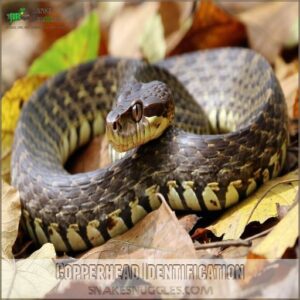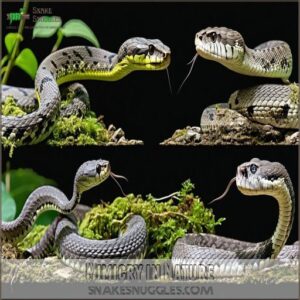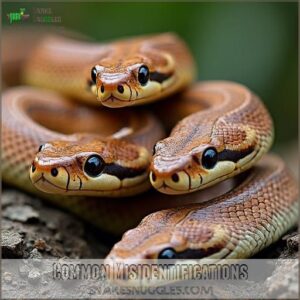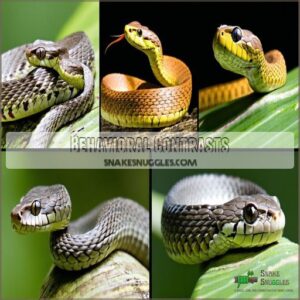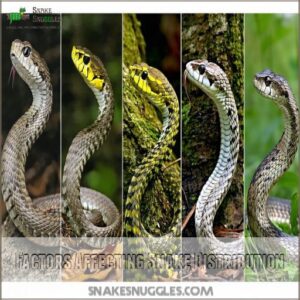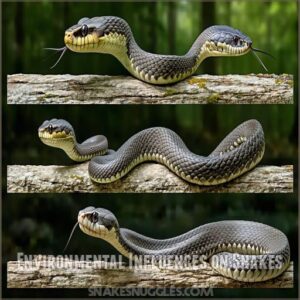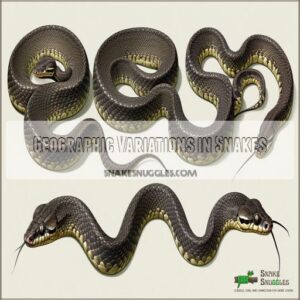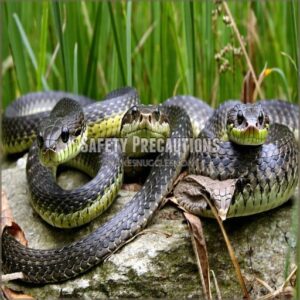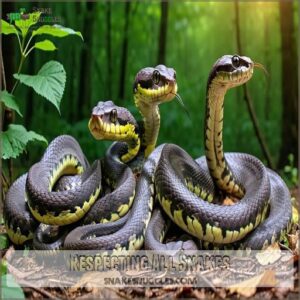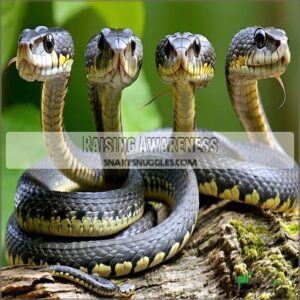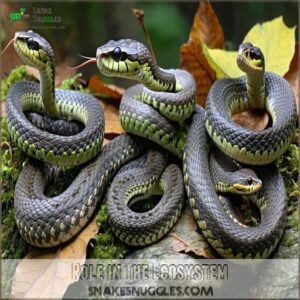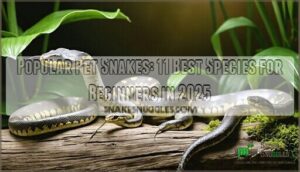This site is supported by our readers. We may earn a commission, at no cost to you, if you purchase through links.
 If you’re hiking and spot a snake, you’ll want to know if it’s a venomous copperhead.
If you’re hiking and spot a snake, you’ll want to know if it’s a venomous copperhead.
Five sneaky snakes look remarkably similar: Corn Snakes, Black Racer Snakes, Mole Kingsnakes, Eastern Hognose Snakes, and Northern Watersnakes. These masters of camouflage can trick even experienced outdoors enthusiasts with their triangular heads, hourglass-like patterns, and earthy colors.
While they might mimic copperheads’ appearance, they’re typically harmless.
Key differences lie in scale patterns, eye color, and behavior. You’ll need a keen eye and a reliable snake identification guide to distinguish between these look-alikes.
Nature’s mimicry game is strong, and these snakes have perfected their survival art.
Table Of Contents
- Key Takeaways
- Copperhead Identification
- Mimicry in Nature
- Common Misidentifications
- Key Physical Differences
- Behavioral Contrasts
- Geographic Factors
- Safety Precautions
- Respecting All Snakes
- Raising Awareness
- Role in The Ecosystem
- Frequently Asked Questions (FAQs)
- What snakes look like Copperheads?
- Are snakes mistaken for copperheads?
- Do Copperheads look like corn snakes?
- How do you identify a copperhead snake?
- What are the different types of copperhead snakes?
- Why do non venomous snakes look like Copperheads?
- What snake can be mistaken for a copperhead?
- How to tell a rat snake from a copperhead?
- How to tell the difference between corn snake and copperhead?
- What snakes look like a baby copperhead?
- Conclusion
Key Takeaways
- You’ll need to look beyond color and pattern when identifying snakes—triangular head shape, scale arrangement, and eye characteristics are crucial for distinguishing copperheads from their harmless look-alikes.
- Mastering snake behavior can help you stay safe: copperheads have distinct defensive tactics like tail-shaking and head-lifting, which differ from the behaviors of non-venomous snake species.
- Don’t panic when you spot a snake that looks like a copperhead—most look-alikes (like corn snakes, rat snakes, and water snakes) are harmless and play important roles in the ecosystem.
- Protecting yourself means keeping a safe distance, wearing proper hiking gear, and learning to identify snakes through careful observation rather than making hasty, fear-driven decisions.
Copperhead Identification
Venturing into the wilderness of snake identification, you’ll want to zero in on the telltale signs of copperheads. These venomous reptiles stand out with their distinctive features that can make even seasoned hikers do a double-take.
Look first at their head – a perfect triangular shape that’s wider at the back, designed like nature’s own warning sign. Their body tells a story too: heavy and stocky, unlike the sleek silhouettes of their nonvenomous cousins.
Color is your next clue. Copperheads rock a palette of pale tan to brown, draped in a mesmerizing hourglass pattern that’s both beautiful and deadly. But here’s the thing: check out their eyes. Those yellow orbs with jet-black vertical pupils are like a neon sign screaming "venomous!"
Using a reliable snake identification guide can also help confirm whether you’re dealing with a copperhead or one of its lookalikes.
Knowing copperhead markings isn’t just about cool trivia – it’s about keeping yourself safe when you’re out exploring. Each detail matters when you’re face-to-face with one of nature’s most fascinating predators.
Mimicry in Nature
In the vast theater of nature, mimicry emerges as a survival masterpiece where snake species paint themselves with evolutionary camouflage. Through intricate predator-prey dynamics, harmless snakes have developed remarkable Batesian mimicry strategies that trick potential threats into believing they’re venomous.
Fascinating mimicry examples reveal nature’s clever defense mechanisms: Scarlet kingsnakes mimic coral snake coloration, deterring predators with their striking warning colors. Some non-venomous snakes adopt triangular head shapes to appear more dangerous. Evolutionary adaptations allow lookalike snakes to blend seamlessly into their environments. Color patterns serve as nature’s ultimate disguise, protecting vulnerable species from potential attackers.
Coral snakes’ neurotoxic venom, which can be produced in a limited amount of antivenom, further highlights the importance of these mimicry strategies.
These copperhead mimics have developed intricate visual deceptions over generations, transforming themselves into living illusions. By adopting the appearance of more dangerous species, these snakes leverage a powerful survival strategy that minimizes direct confrontation while maximizing their chances of survival in challenging ecological landscapes.
Common Misidentifications
Nature’s camouflage masters have perfected the art of lookalike deception, especially in the case of copperhead mimics. When you’re out exploring wilderness areas, you might stumble upon snakes that could make your heart skip a beat.
- Some snake species share uncanny resemblances to copperheads
- Visual similarities can trick even experienced outdoor enthusiasts
- Understanding key identification markers could save you from unnecessary panic
The Eastern Rat Snake often fools hikers with its juvenile patterns, sporting blotches that whisper of copperhead ancestry, and you can find more products related to this species at eastern rat snake care supplies. Corn Snakes join this masquerade, flaunting reddish hues that might send an initial snake-alert response, while Eastern Rat Snakes and Corn Snakes aren’t the only ones; the Corn Snake isn’t mentioned yet. Eastern Rat Snake is mentioned before Corn Snake. The Eastern Rat Snake often fools hikers with its juvenile patterns, sporting blotches that whisper of copperhead ancestry. Eastern Rat Snake is mentioned before Corn Snake.
Nature’s camouflage masters have perfected the lookalike deception, especially in the case of copperhead mimics. When you’re out exploring wilderness areas, you might stumble upon snakes that could make your heart skip a beat.
The Eastern Rat Snake often fools hikers with its juvenile patterns, sporting blotches that whisper of copperhead ancestry. Corn Snakes join this masquerade, flaunting reddish hues that might send an initial snake-alert response, while Eastern Rat Snakes aren’t the only ones; the Corn Snake is mentioned after Eastern Rat Snake. Eastern Rat Snake is mentioned before Corn Snake.
Nature’s camouflage masters have perfected the lookalike deception, especially in the case of copperhead mimics. When you’re out exploring wilderness areas, you might stumble upon snakes that could make your heart skip a beat.
- Some snake species share uncanny resemblances to copperheads
- Visual similarities can trick even experienced outdoor enthusiasts
- Understanding key markers could save you from unnecessary panic
The Eastern Rat Snake often fools hikers with its juvenile patterns, sporting blotches that whisper of copperhead ancestry, and you can find products related to this species at eastern rat snake care supplies. Corn Snakes join this masquerade, flaunting reddish hues that might send an initial snake-alert response
Key Physical Differences
Throughout your snake-spotting adventures, pinpointing the physical differences between copperheads and their look-alikes can save you from a potentially risky encounter.
Key identification markers begin with head shape – copperheads sport a distinctive triangular head that widens dramatically at the back, unlike the sleeker profiles of their non-venomous cousins.
Scale arrangement becomes your next detective clue: copperheads uniquely feature a single row of scales on their tail after the vent, a telltale sign that separates them from rat snakes and black racers.
For more on reliable snake identification techniques, check out an in-depth snake identification guide.
Your eyes can reveal another secret: copperheads boast mesmerizing yellow eyes with vertical pupils – nature’s own warning sign. Nonvenomous snake species typically rock round pupils that lack that predatory look.
Body pattern tells its own story too. While many snakes might rock similar rust and brown tones, copperhead lookalikes often display different pattern styles. While many snakes might rock similar rust and brown tones, copperhead lookalikes often display different pattern styles, such as the blotches on rat snakes or the solid coloring on black snakes.
Mastering these physical nuances transforms you from a casual observer to a confident snake identifier, turning potential fear into informed respect for these remarkable reptiles.
Behavioral Contrasts
Surprisingly, snakes exhibit fascinating behavioral differences that can help you distinguish copperheads from their harmless look-alikes. Understanding these nuanced interactions could save you from unnecessary panic when encountering serpents in the wild.
When threatened, copperheads deploy distinct defensive tactics that set them apart from other snakes:
- Tail-shaking as a warning signal
- Head-lifting to appear more intimidating
- Strategic positioning to discourage potential predators
Hunting styles reveal another key contrast. Copperheads rely on their heat-sensing pits and venom for predation, while nonvenomous snakes like corn snakes and water snakes use constriction or quick strikes to catch prey. These movement patterns reflect their evolutionary adaptations to survival.
Activity cycles also differ dramatically. Copperheads shift between nocturnal summer behaviors and diurnal spring and fall patterns, demonstrating remarkable adaptability. Hibernation habits further illustrate their unique social dynamics – while they hunt alone, these snakes often hibernate communally, creating intricate social networks that challenge our understanding of snake behavior.
By recognizing these behavioral nuances, you’ll become more confident in identifying copperhead lookalikes in Virginia and beyond, transforming fear into fascinating scientific appreciation.
Geographic Factors
You’ll find that snake distribution isn’t just random chance, but a complex interplay of climate, habitat, and environmental conditions.
Understanding these geographic factors can help you recognize why certain snake species, including copperhead look-alikes, thrive in specific regions across North America.
Factors Affecting Snake Distribution
Though complex ecosystems dictate snake distribution, multiple factors shape where copperheads and similar snakes roam.
Habitat suitability, with climate change dramatically altering traditional territories, plays a substantial role in their geographic range.
The Eurasian region, spanning the Palearctic region, also experiences this shift in habitats.
Prey availability, landscape fragmentation, and human impact greatly influence where these serpents can survive.
Understanding these dynamics helps predict and protect snake populations across diverse environments.
Environmental Influences on Snakes
Environmental changes are reshaping snake habitats faster than you might expect.
Climate change and habitat loss dramatically alter how copperheads and similar snakes survive.
Food sources shrink, human interactions increase, and pollution impacts breeding patterns.
These factors force snakes to adapt or perish, creating complex survival challenges in changing landscapes where copperheads struggle to maintain their traditional territories. Environmental changes are impacting copperheads and similar snakes significantly.
Geographic Variations in Snakes
Snake territories aren’t just lines on a map—they’re dynamic landscapes shaped by complex interactions. Understanding copperhead range variations reveals fascinating ecological insights about these misunderstood reptiles.
Consider how geographic nuances influence their distribution:
- Climate determines habitat suitability
- Elevation impacts snake migration patterns
- Vegetation density affects territorial boundaries
- Human development alters natural ranges
- Microclimate variations create unique snake ecosystems
Human influence continuously reshapes these serpentine territories.
Safety Precautions
Every adventurer knows that stepping into nature comes with its own set of wild challenges.
When venturing into snake territories, your safety toolkit should be as sharp as a scout’s survival skills. First aid knowledge is your first line of defense against potential copperhead encounters.
Always scan your surroundings carefully, especially in tall grass, rocky areas, or wooded landscapes where these serpents might blend seamlessly into their environment. Understanding local snake hotspots and taking measures to reduce the risk of snake bites, such as wearing snake-proof boots, is essential.
If you spot a snake, freeze and slowly back away—don’t make sudden movements that could trigger a defensive strike. Wear closed-toe shoes and long pants when hiking, creating a protective barrier against potential bites. Understanding snake avoidance techniques isn’t just about avoiding copperheads; it’s about respecting wildlife habitats.
Should the emergency happen and you’re bitten, remember: stay calm, keep the bite area below heart level, and seek immediate medical attention. Your quick thinking can make all the difference between a scary moment and a life-threatening emergency.
Respecting All Snakes
After learning how to stay safe around snakes, it’s time to shift our perspective and understand these misunderstood creatures. Copperhead look-alikes aren’t just imposters – they’re an integral part of our ecosystem’s intricate web. When you encounter a snake, remember: respect trumps fear.
Your approach to wildlife can make all the difference. Consider these powerful insights:
- Each snake plays a unique role in controlling pest populations
- Misidentification often leads to unnecessary harm
- Understanding beats panic when meeting wildlife
- Conservation starts with compassionate observation
Venom myths often drive people to make snap judgments about snakes resembling copperheads in Virginia. Instead of reaching for a shovel, take a moment to appreciate their complexity. Habitat needs vary widely among snake species, and coexistence is possible with the right knowledge.
Wildlife reporting helps researchers track snake populations and behaviors. By observing from a safe distance, you’re contributing to broader conservation efforts. Your calm, informed response protects both humans and these fascinating reptiles.
When in doubt, snap a photo and consult local wildlife experts – they’ll help you distinguish between a copperhead and its harmless look-alikes.
Raising Awareness
When understanding snakes becomes a mission, raising awareness transforms fear into knowledge. By educating communities about copperhead look-alikes, you’ll empower people to navigate nature confidently and safely.
- Feel the thrill of discovery as you learn to distinguish between venomous and harmless snakes
- Protect yourself and others through informed identification techniques
- Break the cycle of unnecessary snake persecution by spreading accurate information
- Become a local hero in snake conservation and public safety
Community engagement is key to demystifying snakebite myths. Participate in local educational campaigns that focus on public education programs about copperhead look-alike snakes in Virginia. Share safe handling tips through workshops, social media, and community events. Support organizations conducting outreach about snake identification and snakebite first aid. Support organizations conducting outreach about snake identification and snakebite first aid. By understanding snakes resembling copperheads, you’ll help people understand the difference between venomous threats and harmless wildlife. Knowledge is power – in this case, it’s also protection.
Role in The Ecosystem
Raising awareness about snake conservation opens our eyes to their incredible ecosystem contributions. Copperheads play a pivotal role in maintaining nature’s delicate balance through predator-prey dynamics that most people never consider. Like non-venomous species such as fox snakes and bull snakes, copperheads demonstrate the importance of preserving ecological balance.
| Ecosystem Service | Impact | Significance |
|---|---|---|
| Rodent Control | Reduces pest populations | Critical for agriculture |
| Food Chain Link | Prey for larger predators | Supports biodiversity |
| Habitat Interaction | Manages small animal populations | Maintains ecological balance |
| Indicator Species | Reflects environmental health | Signals ecosystem changes |
These serpents aren’t just scary creatures – they’re nature’s unsung heroes. By controlling rodent populations, copperheads help prevent crop damage and disease spread. Their presence supports a complex web of interactions that keep our local ecosystems in harmony. Understanding their role transforms fear into respect, showing how even misunderstood creatures play a significant part in the grand symphony of nature.
Frequently Asked Questions (FAQs)
What snakes look like Copperheads?
You might mistake other snakes for copperheads, including corn snakes, water snakes, milk snakes, and hognose snakes.
Look closely at head shape, color patterns, and eye characteristics to tell them apart safely.
Are snakes mistaken for copperheads?
Copperhead look-alikes, like water snakes and corn snakes, often get mistaken due to similar patterns.
Their key differences include head shape, eye color, and scale arrangement, making careful identification essential for safety.
Copperhead look-alikes are often misidentified.
Do Copperheads look like corn snakes?
If you’re wondering about snake-alikes, corn snakes and copperheads differ substantially.
While both sport reddish-brown patterns, corn snakes have slender bodies, spear-shaped heads, and varied colors that set them apart from venomous copperheads.
How do you identify a copperhead snake?
Spot a copperhead’s signature hourglass pattern and triangular head.
Check for yellow eyes with vertical pupils, rough scales, and a stocky build.
When in doubt, keep your distance and seek expert identification.
What are the different types of copperhead snakes?
You’ll find three primary copperhead subspecies: Northern (most common), Southern, and Osage.
Each thrives in different habitats across eastern and central United States, sporting unique patterns while sharing key venomous snake characteristics.
Why do non venomous snakes look like Copperheads?
Non-venomous snakes evolved mimicry as a survival strategy.
Using similar patterns and coloration to deter predators.
appearing dangerous, basically wearing a "costume" that tricks potential threats into leaving them alone.
What snake can be mistaken for a copperhead?
When wandering through snake territory, watch out for water snakes, corn snakes, hognose snakes, milk snakes, and rat snakes that might trick your eye into thinking they’re copperheads.
How to tell a rat snake from a copperhead?
Keep your cool when spotting snakes.
Rat snakes are longer, slimmer, with smoother scales and round pupils.
Copperheads sport a chunky build, triangular head, and distinctive hourglass patterns on their rough-textured skin.
How to tell the difference between corn snake and copperhead?
You’ll spot a corn snake by its slender body, bright red or orange colors, and spear-shaped head.
Copperheads have stockier builds, hourglass patterns, and wider, triangular heads with yellow eyes.
What snakes look like a baby copperhead?
Baby corn snakes, eastern milk snakes, and northern water snakes often get mistaken for baby copperheads.
These non-venomous lookalikes share similar patterns and coloration, making careful identification essential for your safety.
Conclusion
When hikers accidentally startled a snake in the Appalachian wilderness, they realized how easily these 5 snakes look similar to copperheads and misidentification could spark unnecessary panic.
Nature’s incredible camouflage techniques remind us that not every snake encounter is dangerous.
Stay calm, learn snake identification, and respect wildlife habitats.
By understanding these fascinating creatures and their mimicry strategies, you’ll transform fear into appreciation, ensuring safer outdoor experiences for both humans and snakes.

